ERT and GPR Prospecting Applied to Unsaturated and Subwater Analogue Archaeological Site in a Full Scale Laboratory
Abstract
1. Introduction
2. Theoretical Notes
3. Materials and Methods
3.1. The Full-Scale Archaeologeophysical Test
3.2. Geophysical Surveys
4. Results
4.1. WP1—Unsaturated Scenarios
4.1.1. GPR Results in WP1
4.1.2. ERT Results in WP1
4.2. WP2—Underwater Scenario
5. Discussion
6. Conclusions
Author Contributions
Funding
Institutional Review Board Statement
Informed Consent Statement
Data Availability Statement
Acknowledgments
Conflicts of Interest
References
- Rizzo, E.; Chianese, D.; Lapenna, V. Integration of magnetometric, GPR and geoelectric measurements applied to the archaeological site of Viggiano (Southern Italy, Agri Valley-Basilicata). Near Surf. Geophys. 2005, 3, 13–19. [Google Scholar] [CrossRef]
- Campana, S.; Dabas, M.; Marasco, L.; Piro, S.; Zamuner, D. Integration of remote sensing, geophysical surveys and arcaheological excavations for the study of a medieval mound (Tuscany, Italy). Archaeol. Prospect. 2009, 16, 167–176. [Google Scholar] [CrossRef]
- Piro, S.; Ceraudo, G.; Zamuner, D. Integrated Geophysical and Archaeological Investigations of Aquinum in Frosinone, Italy. Archaeol. Prospect. 2011, 18, 127–138. [Google Scholar] [CrossRef]
- Filzwieser, R.; Olesen, L.H.; Neubauer, W. Large-scale geophysical archaeological prospection pilot study at Viking Age and medieval sites in west Jutland, Denmark. Archaeol. Prospect. 2017, 24, 373–393. [Google Scholar] [CrossRef]
- Tsokas, G.N.; Tsourlos, P.I.; Kim, J.-H.; Papazachos, C.B.; Vargemezis, G.; Bogiatzis, P. Assessing the Condition of the Rock Mass over the Tunnel of Eupalinus in Samos (Greece) using both Conventional Geophysical Methods and Surface to Tunnel Electrical Resistivity Tomography. Archaeol. Prospect. 2014, 21, 277–291. [Google Scholar] [CrossRef]
- Leucci, G.; Parise, M.; Sammarco, M.; Scardozzi, G. The Use of Geophysical Prospections to Map Ancient Hydraulic Works: The Triglio Underground Aqueduct (Apulia, Southern Italy). Archaeol. Prospect. 2016, 23, 195–211. [Google Scholar] [CrossRef]
- Capozzoli, L.; Catapano, I.; De Martino, G.; Gennarelli, G.; Ludeno, G.; Rizzo, E.; Soldovieri, F.; Uliano Scelza, F.; Zuchtriegel, G. The Discovery of a Buried Temple in Paestum: The Advantages of the Geophysical Multi-Sensor Application. Remote Sens. 2020, 12, 2711. [Google Scholar] [CrossRef]
- Binley, A.; Hubbard, S.S.; Huisman, J.A.; Revil, A.; Robinson, D.A.; Singha, K.; Slater, L.D. The emergence of hydrogeophysics for improved understanding of subsurface processes over multiple scales. Water Resour. Res. 2015, 51, 3837–3866. [Google Scholar] [CrossRef]
- Bowens, A. Underwater Archaeology—The NAS Guide to Principles and Practice, 2nd ed.; Nautical Archaeological Society: Wales, UK, 2012; ISBN 978-1-405-17592-0. [Google Scholar]
- Winton, T. Quantifying Depth of Burial and Composition of Shallow Burie Archaeological Material: Integrated Sub-bottom Profiling and 3D Survey Approaches. In 3D Recording and Interpretation for Maritime Archaeology; Mc Carthy, J.K., Benjamin, J., Winton, T., van Duivenvoorde, W., Eds.; Springer: New York, NY, USA, 2019. [Google Scholar]
- Westley, K.; Mcneary, R. Archaeological Applications of Low-Cost Integrated Sidescan Sonar/Single-Beam Echosounder Systems in Irish Inland Waterways. Archaeol. Prospect. 2017, 24, 37–57. [Google Scholar] [CrossRef]
- Tizzard, L.; Bicket, A.R.; Benjamin, J.; Loecker, D.D. A Middle Palaeolithic site in the southern North Sea: Investigating the archaeology and palaeogeography of Area 240. J. Quat. Sci. 2014, 29, 698–710. [Google Scholar] [CrossRef]
- Zielhofer, C.; Rabbel, W.; Wunderlich, T.; Vött, A.; Berg, S. Integrated geophysical and (geo)archaeological explorations in wetlands. Quat. Int. 2018, 473, 1–2. [Google Scholar] [CrossRef]
- Abramov, A.; Vasiliev, A. Underwater ground penetrating radar in archeological investigation below sea bottom. In Proceedings of the Tenth International Conference on Grounds Penetrating Radar, Delft, The Netherlands, 21–24 June 2004; IEEE: Piscataway, NJ, USA, 2004; pp. 455–458. [Google Scholar]
- Ruffell, A. Under-water scene investigation using ground penetrating radar (GPR) in the search for a sunken jet ski, Northern Ireland. Sci. Justice 2006, 46, 221–230. [Google Scholar] [CrossRef]
- Yang, C.H.; Tong, L.T.; Yu, C.Y. Integrating GPR and RIP methods for water surface detection of geological structures. Terr. Atmos. Ocean. Sci. 2006, 17, 391–404. [Google Scholar] [CrossRef][Green Version]
- Qin, T.; Zhao, Y.; Lin, G.; Hu, S.; An, C.; Geng, D.; Rao, C. Underwater archaeological investigation using ground penetrating radar: A case analysis of Shanglinhu Yue Kiln sites (China). J. Appl. Geophys. 2018, 154, 11–19. [Google Scholar] [CrossRef]
- Ruffell, A.; Parker, R. Water penetrating radar. J. Hydrol. 2021, 597, 126300. [Google Scholar] [CrossRef]
- Giampaolo, V.; Capozzoli, L.; Grimaldi, S.; Rizzo, E. Sinkhole risk assessment by ERT: The case study of Sirino Lake (Basilicata, Italy). Geomorphology 2016, 253, 1–9. [Google Scholar] [CrossRef]
- Dahlin, T.; Loke, M.H. Underwater ERT surveying in water with resistivity layering with example of application to site investigation for a rock tunnel in central Stockholm. Near Surf. Geophys. 2018, 16, 230–237. [Google Scholar] [CrossRef]
- Simyrdanis, K.; Bailey, M.; Moffat, I.; Roberts, A.; van Duivenvoorde, W.; Savvidis, A.; Cantoro, G.; Bennett, K.; Kowlessar, J. Resolving Dimensions: A Comparison Between ERT Imaging and 3D Modelling of the Barge Crowie, South Australia. In 3D Recording and Interpretation for Maritime Archaeology; Mc Carthy, J.K., Ed.; Springer: New York, NY, USA, 2019. [Google Scholar]
- Papadopoulos, N.; Oikonomou, D.; Simyrdanis, K.; Heng, L.M. Practical considerations for shallow submerged archaeological prospection with 3-D electrical resistivity tomography. Archaeol. Prospect. 2021, 28, 1–21. [Google Scholar] [CrossRef]
- De Souza, H.; Sampaio, E.E.S. Apparent resistivity and spectral induced polarization in the submarine environment. An. Acad. Bras. Cienc. 2001, 73, 429–444. [Google Scholar] [CrossRef]
- Kwon, H.; Kim, J.; Ahn, H.; Yoon, J.; Kim, K.; Jung, C.; Lee, S.; Uchida, T. Delineation of fault zone beneath a riverbed by an electrical resistivity survey using a floating stream cable. Explor. Geophys. 2005, 36, 50–58. [Google Scholar] [CrossRef]
- Freyer, P.A.; Nyquist, J.E.; Toran, L.E. Use of underwater resistivity in the assessment of groundwater–surface water interaction within the burd run watershed. In Proceedings of the Annual Symposium on the Application of Geophysics to Engineering and Environmental Problems 8; Environmental and Engineering Geophysical Society: Seattle, WA, USA, 2006. [Google Scholar]
- Losito, G.; Aminti, P.L.; Martelletti, L.; Grandjean, J.-M.; Mazzetti, A.; Trova, A.; Benvenuti, G. Marine geoelectrical prospecting for soft structures characterization in shallow water: Field and laboratory test. In Proceedings of the EAGE 69th Conference & Exhibition, London, UK, 11–14 June 2007; European Association of Geoscientists & Engineers: Houten, The Netherlands, 2007. [Google Scholar]
- Crook, N.; Binley, A.; Knight, R.; Robinson, D.A.; Zarnetske, J.; Haggerty, R. Electrical resistivity imaging of the architecture of substream sediments. Water Resour. Res. 2008, 44, W00D13. [Google Scholar] [CrossRef]
- Nyquist, J.E.; Freyer, P.A.; Toran, L. Stream bottom resistivity tomography to map ground water discharge. Ground Water 2008, 46, 561–569. [Google Scholar] [CrossRef] [PubMed]
- Henderson, R.D.; Day-Lewis, F.D.; Abarca, E.; Harvey, C.F.; Karam, H.N.; Liu, L.; Lane, J.W. Marine electrical resistivity imaging of submarine groundwater discharge: Sensitivity analysis and application in Waquoit Bay, Massachusetts, USA. Hydrogeol. J. 2010, 18, 173–185. [Google Scholar] [CrossRef]
- Day-Lewis, F.D.; White, E.A.; Johnson, C.D.; Lane, J.W.J.R.; Belaval, M. Continuous resistivity profiling to delineate submarine groundwater discharge—Examples and limitations. Lead. Edge 2006, 25, 724–728. [Google Scholar] [CrossRef]
- Castilho, G.; Maia, D. A successful mixed land underwater 3D resistivity survey in an extremely challenging environment in Amazônia. In Proceedings of the 21st EEGS Symposium on the Application of Geophysics to Engineering and Environmental Problems, Philadelphia, PA, USA, 6–10 April 2008; Environmental and Engineering Geophysical Society (EEGS): Denver, CO, USA, 2008; pp. 1150–1158. [Google Scholar]
- Baumgartner, F. A new method for geoelectrical investigations underwater. Geophys. Prospect. 1996, 44, 71–98. [Google Scholar] [CrossRef]
- Mansoor, N.; Slater, L. Aquatic electrical resistivity imaging of shallow-water wetlands. Geophysics 2007, 72, F211–F221. [Google Scholar] [CrossRef]
- Loke, M.H.; Lane, J.W., Jr. Inversion of Data from Electrical Resistivity Imaging Surveys in Water-Covered Areas. Explor. Geophys. 2004, 35, 266–271. [Google Scholar] [CrossRef]
- Rizzo, E.; Straface, S.; Chidichimo, S.; Votta, M.; Lapenna, V. First hydrogeophysical controlled experiments in the large lab-scale Hydrogeosite Laboratory (IMAA-CNR). Geophys. Res. Abstr. 2008, 10, 9492. [Google Scholar]
- Capozzoli, L.; Caputi, A.; De Martino, G.; Giampaolo, V.; Luongo, R.; Perciante, F.; Rizzo, E. Electrical and electromagnetic techniques applied to an archaeological framework reconstructed in laboratory. In Advanced Ground Penetrating Radar (IWAGPR), Proceedings of the 2015 8th International Workshop on Advanced Ground Penetrating Radar, Firenze, Italy, 7–10 July 2015; IEEE: Piscataway, NJ, USA, 2015. [Google Scholar]
- Capozzoli, L.; De Martino, G.; Giampaolo, V.; Perciante, F.; Rizzo, E. Geophysical techniques applied to investigate underwater structures. In Advanced Ground Penetrating Radar (IWAGPR), Proceedings of the 2017 9th International Workshop on Advanced Ground Penetrating Radar, Edimbourgh, Scotland, 28–30 June 2017; IEEE: Piscataway, NJ, USA, 2017. [Google Scholar]
- Ludeno, G.; Capozzoli, L.; Rizzo, E.; Soldovieri, F.; Catapano, I. A Microwave Tomography Strategy for Underwater Imaging via Ground Penetrating Radar. Remote Sens. 2018, 10, 1410. [Google Scholar] [CrossRef]
- Rizzo, E.; Capozzoli, L. Integrated Geophysical Techniques for Archaeological Remains: Real Cases and Full Scale Laboratory Example. In Archaeogeophysics; El-Qady, G., Metwaly, M., Eds.; Springer International Publishing AG, Part of Springer Nature: New York, NY, USA, 2019; Chapter 13. [Google Scholar] [CrossRef]
- Goodman, D.; Piro, S. GPR Remote Sensing in Archaeology; Springer: London, UK, 2013. [Google Scholar]
- Daniels, D.J. Ground Penetrating Radar, 2nd ed.; The Institute of Electrical Engineers: London, UK, 2004. [Google Scholar]
- Davis, J.L.; Annan, A.P. Ground penetrating radar for high-resolution mapping of soil and rock stratigraphy. Geophys. Prospect. 1989, 37, 531–551. [Google Scholar] [CrossRef]
- Doolittle, J.A.; Collins, M.E. Use of soil information to determine application of ground-penetrating radar. J. Appl. Geophys. 1995, 33, 101–108. [Google Scholar] [CrossRef]
- Walther, E.G.; Pitchford, A.M.; Olhoeft, G.R. A strategy for detecting subsurface organic contaminants. In The Petroleum Hydrocarbons and Organic Chemicals in Ground Water, Prevention, Detection and Restoration; National Water Well Association: Houston, TX, USA, 1986; pp. 357–381. [Google Scholar]
- Capozzoli, L.; Mutino, S.; Liseno, M.G.; De Martino, G. Searching for the History of the Ancient Basilicata: Archaeogeophysics Applied to the Roman Site of Forentum. Heritage 2019, 2, 1097–1116. [Google Scholar] [CrossRef]
- Vickers, R.S.; Dolphin, L.T. A communication on an archaeological radar experiment at Chaco Canyon, New Mexico. MASCA Newslett. 1975, 11, 6–8. [Google Scholar]
- Nishimura, Y.; Goodman, D. Ground penetrating radar survey at Wroxeter. Archaeol. Prospect. 2000, 7, 101–105. [Google Scholar] [CrossRef]
- Neubauer, W.; Eder-Hinterleitner, A.; Seren, S.; Melichar, P. Georadar in the Roman civil town Carnuntum, Austria: An approach for archaeological interpretation of GPR data. Archaeol. Prospect. 2002, 9, 135–156. [Google Scholar] [CrossRef]
- Conyers, L.B.; Ernenwein, E.G.; Bedal, L.A. Ground-penetrating radar discovery at Petra, Jordan. Antiquity 2009, 76, 339–340. [Google Scholar] [CrossRef]
- Gaffney, V.; Patterson, H.; Piro, S.; Goodman, D.; Nishimura, Y. Multimethodological approach to study and characterise Forum Novum (Vescovio, Central Italy). Archaeol. Prospect. 2004, 11, 201–212. [Google Scholar] [CrossRef]
- Piro, S.; Goodman, D.; Nishimura, Y. The study and characterization of Emperor Traiano’s villa using high-resolution integrated geophysical surveys. Archaeol. Prospect. 2003, 10, 1–25. [Google Scholar] [CrossRef]
- Chianese, D.; D’Emilio, M.; Di Salvia, S.; Lapenna, V.; Ragosta, M.; Rizzo, E. Magnetic Mapping, Ground Penetrating Radar Surveys and Magnetic Susceptibility Measurements for the Study of the Archaeological Site of Serra di Vaglio (Southern Italy). J. Archaeol. Sci. 2004, 31, 633–643. [Google Scholar] [CrossRef]
- Goodman, D.; Piro, S.; Nishimura, Y.; Patterson, H.; Gaffney, V. Discovery of a 1st century AD Roman amphitheater and other structures at the Forum Novum by GPR. J. Environ. Eng. Geophys. 2004, 9, 35–41. [Google Scholar] [CrossRef]
- Seren, S.; Eder-Hinterleitner, A.; Neubauer, W.; Löcker, K.; Melichar, P. Extended comparison of different GPR systems and antenna configurations at the Roman site Carnuntum. Near Surf Geophys. 2007, 5, 389–394. [Google Scholar] [CrossRef]
- Campana, S.; Piro, S. Seeing the Unseen—Geophysics and Landscape Archaeology; CRC Press: London, UK, 2009; Volume 2, 376p, ISBN 978-0-415-44721-8. [Google Scholar]
- Novo, A.; Sala, R.; Garcìa, E.; Tamba, R.; Muñoz, F.; Solla, M.; Lorenzo, H. From Celtiberians to Romans: Combined geophysical (3D GPR and fluxgate gradiometer) prospection for the archaeological characterization of Castro de la Magdalena (Leon, Spain). ArchaeoSciences 2009, 33, 121–124. [Google Scholar] [CrossRef]
- Grasmueck, M.; Weger, R.; Horstmeyer, H. Three-dimensional ground-penetrating radar imaging of sedimentary structures, fractures, and archaeological features at submeter resolution. Geology 2004, 32, 933–936. [Google Scholar] [CrossRef]
- Grasmueck, M.; Weger, R.; Horstmeyer, H. Full-resolution 3D imaging. Geophysics 2005, 70, 12–19. [Google Scholar] [CrossRef]
- Annan, P. Electromagnetic principles of ground penetrating radar. In Ground Penetrating Radar: Theory and Applications; Jol, H.M., Ed.; Elsevier: Amsterdam, The Netherlands, 2009; pp. 1–40. ISBN 978-0-444-53348-7. [Google Scholar]
- Bavusi, M.; Giocoli, A.; Rizzo, E.; Lapenna, V. Geophysical characterisation of Carlo’s V Castle (Crotone, Italy). J. Appl. Geophys. 2009, 67, 386–401. [Google Scholar] [CrossRef]
- Rizzo, E.; Masini, N.; Lasaponara, R.; Orefici, G. ArchaeoGeophysical methods in the Templo del Escalonado (Cahuachi, Nasca, Perù). Near Surf. Geophys. 2010, 8, 433–439. [Google Scholar] [CrossRef]
- Rizzo, E.; Santoriello, A.; Capozzoli, L.; De Martino, G.; De Vita, C.B.; Musmeci, D.; Perciante, F. Geophysical survey and archaeological data at Masseria Grasso (BN, Italy). Surv. Geophys. 2018, 39, 1201–1217. [Google Scholar] [CrossRef]
- Zhao, W.; Tian, G.; Forte, E.; Pipan, M.; Wang, Y.; Li, X.; Shi, Z.; Liu, H. Advances in GPR data acquisition and analysis for archaeology. Geophys. J. Int. 2015, 202, 62–71. [Google Scholar] [CrossRef]
- Binley, A.; Kemna, A. DC resistivity and induced polarization methods. In Hydrogeophysics; Rubin, Y., Hubbard, S.S., Eds.; (Water Science and Technology Library Ser. 50); Springer: New York, NY, USA, 2005; pp. 129–156. [Google Scholar]
- Chang, P.Y.; Chang, S.K.; Liu, H.C.; Wang, S.C. Using integrated 2D and 3D resistivity imaging methods for illustrating the mud-fluid conduits of the Wushanting mud volcanoes in southwestern Taiwan. Terr. Atmos. Ocean. Sci. 2011, 22, 1–14. [Google Scholar] [CrossRef][Green Version]
- Loke, M.H.; Barker, R.D. Practical techniques for 3D resistivity surveys and data inversion. Geophys. Prosp. 1996, 44, 499–523. [Google Scholar] [CrossRef]
- DeGroot-Hedlin, C.; Constable, S. Occams’ inversion to generate smooth, two-dimensional models from magnetotelluric data. Geophysics 1990, 55, 1613–1624. [Google Scholar] [CrossRef]
- Noel, M.; Xu, B. Archaeological investigation by electrical resistivity tomography: A preliminary study. Geophys. J. Int. 1991, 107, 95–102. [Google Scholar] [CrossRef]
- Tsokas, G.N.; Giannopoulos, A.; Tsourlos, P.; Vargemezis, G.; Tealby, J.M.; Sarris, A.; Papazachos, C.B.; Savopoulou, T. A large scale geophysical survey in the archaeological site of Europos (northern Greece). J. Appl. Geophys. 1994, 32, 85–98. [Google Scholar] [CrossRef]
- Piro, S.; Tsourlos, P.; Tsokas, G.N. Cavity detection employing advanced geophysical techniques: A case study. Eur. J. Environ. Eng. Geophys. 2001, 6, 3–31. [Google Scholar]
- Drahor, M.G.; Berge, M.A.; Kurtulmus, T.O.; Hartmann, M.; Speidel, M.A. Magnetic and Electrical Resistivity Tomography Investigations in a Roman Legionary Camp Site (Legio IV Scythica) in Zeugma, Southeastern Anatolia, Turkey. Archaeol. Prospect. 2008, 15, 159–186. [Google Scholar] [CrossRef]
- Cardarelli, E.; Fishanger, F.; Piro, S. Integrated geophysical survey to detect buried structures for archaeological prospecting. A case-history at Sabine Necropolis (Rome—Italy). Near Surf. Geophys. 2007, 6, 15–20. [Google Scholar] [CrossRef]
- Elwaseif, M.; Slater, L. Quantifying tomb geometries in resistivity images using watershed algorithms. J. Archaeol. Sci. 2010, 37, 1424–1436. [Google Scholar] [CrossRef]
- Passaro, S. Marine electrical resistivity tomography for shipwreck detection in very shallow water: A case study from Agropoli (Salerno, Southern Italy). J. Archaeol. Sci. 2010, 37, 1989–1998. [Google Scholar] [CrossRef]
- Trogu, A.; Ranieri, G.; Calcina, S.; Piroddi, L. The Ancient Roman Aqueduct of Karales (Cagliari, Sardinia, Italy): Applicability of Geophysics Methods to Finding the Underground Remains. Archaeol. Prospect. 2014, 3, 157–168. [Google Scholar] [CrossRef]
- Tonkov, N.; Loke, M.H. A resistivity survey of a burial mound in the Valley of the Thracian Kings’. Archaeol. Prospect. 2006, 13, 129–136. [Google Scholar] [CrossRef]
- Astin, T.; Eckardt, H.; Hay, S. Resistivity imaging survey of the Roman barrows at Bartlow, Cambridgeshire, UK. Archaeol. Prospect. 2007, 14, 24–37. [Google Scholar] [CrossRef]
- Chianese, D.; Lapenna, V.; Di Salvia, S.; Perrone, A.; Rizzo, E. Joint geophysical measurements to investigate the rossano of Vaglio archaeological site (Basilicata Region, Southern Italy). J. Archaeol. Sci. 2010, 37, 2237–2244. [Google Scholar] [CrossRef]
- Espino, D.; Tejero-Andrade, A.; Cifuentes-Nava, G.; Iriarte, L.; Farías, S.; Chávez, R.E.; López, F. 3D electrical prospection in the archaeological site El Pahñu, Hidalgo State, Central Mexico. J. Archaeol. Sci. 2013, 40, 1213–1223. [Google Scholar] [CrossRef]
- Tsourlos, P.; Papadopoulos, N.; Papazachos, C.; Yi, M.-J.; Kim, J.-H. Efficient 2D inversion of long ERT sections. J. Appl. Geophys. 2014, 105, 213–224. [Google Scholar] [CrossRef]
- Capizzi, P.; Cosentino, P.L.; Fiandaca, G.; Martorana, R.; Messina, P.; Vassallo, S. Geophysical investigations in the archaeological site of Himera (Northern Sicily). Near Surf. Geophys. 2007, 5, 417–426. [Google Scholar] [CrossRef]
- Negri, S.; Leucci, G.; Mazzone, F. High resolution 3D ERT to help GPR data interpretation for researching archaeological items in a geologically complex subsurface. J. Appl. Geophys. 2008, 65, 111–120. [Google Scholar] [CrossRef]
- Keay, S.; Earl, G.; Hay, S.; Kay, S.; Ogden, J.; Strutt, K.D. The role of integrated geophysical survey methods in the assessment of archaeological landscapes: The case of Portus. Archaeol. Prospect. 2009, 16, 154–166. [Google Scholar] [CrossRef]
- Orlando, L. GPR to constrain ERT data inversion in cavity searching: Theoretical and practical applications in archeology. J. Appl. Geophys. 2013, 89, 35–47. [Google Scholar] [CrossRef]
- Jiang, A.; Chen, F.; Masini, N.; Capozzoli, L.; Romano, G.; Sileo, M.; Yang, R.; Tang, P.; Chen, P.; Lasaponara, R. Archaeological crop marks identified from Cosmo-SkyMed time series: The case of Han-Wei capital city, Luoyang, China. Int. J. Digit. Earth (TJDE) 2017, 10, 846–860. [Google Scholar] [CrossRef]
- Masini, N.; Capozzoli, L.; Chen, P.; Chen, F.; Romano, G.; Lu, G.; Tang, P.; Sileo, M.; Ge, Q.; Lasaponara, R. Towards an operational use of Remote Sensing in Archaeology in Henan (China): Archaeogeophysical investigations, approach and results in Kaifeng. Remote Sens. 2017, 9, 809. [Google Scholar] [CrossRef]
- Rizzo, E.; Capozzoli, L.; de Martino, G.; Grimaldi, S. Urban Geophysical approach to characterize the subsoil of the main square in San Benedetto del Tronto town (Italy). J. Eng. Geol. 2019, 257, 105133. [Google Scholar] [CrossRef]
- Capozzoli, L.; de Martino, G.; Capozzoli, V.; Duplouy, A.; Henning, A.; Rizzo, E. The pre-Roman hilltop settlement of Monte Torretta di Pietragalla: First results of the geophysical survey. Archaeol. Prospect. 2021, 28, 1–14. [Google Scholar] [CrossRef]
- Giovannoni, G. La Tecnica delle Costruzioni Presso i Romani; Società Editrice di Arte Illustrate: Rome, Italy, 1925. [Google Scholar]
- Lugli, G. La Tecnica Edilizia Romana; Giovanni Bardi: Rome, Italy, 1957. [Google Scholar]
- Adam, J.P. L’arte di Costruire Presso i Romani; Materiale e Tecniche; Longanesi: Milano, Italy, 1998. [Google Scholar]
- Giuliani, C.F.; Ferretti, A.S. Opus cementicium. Il materiale e la tecnica costruttiva, Atti del seminario (Roma, facoltà di Ingegneria, 11/06/1997). In Materie e Strutture; fasc. 2–3; L’Erma di Bretschneider: Rome, Italy, 1997. [Google Scholar]
- Giuffrè, A. Letture sulla Meccanica delle Murature Storiche; Kappa Ed: Rome, Italy, 1999. [Google Scholar]
- Le Pera, S. Come Costruivano Gli Antichi Romani: Brevi Note di Tecnica Edilizia; Palombi Editore: Roma, Italy, 1999. [Google Scholar]
- Caleca, L. Architettura Tecnica; Flaccovio Editore: Palermo, Italy, 2000. [Google Scholar]
- Rocchietti, D. Aree Sepolcrali a Metaponto; Consiglio Regionale della Basilicata: Potenza, Italy, 2002. [Google Scholar]
- Giuliani, C.F. L’edilizia nell’Antichità; Carocci: Rome, Italy, 2006. [Google Scholar]
- Morelli, G.; LaBrecque, D.J. Advances in ERT inverse modelling. Eur. J. Environ. Eng. Geophys. 1996, 1, 171–186. [Google Scholar]
- Blanchy, G.; Saneiyan, S.; Boyd, J.; McLachlan, P.; Binley, A. ResIPy, an intuitive open source software for complex geoelectrical inversion/modeling. Comput. Geosci. 2020, 137, 104423. [Google Scholar] [CrossRef]
- Liu, L.; Lane, J.W.; Quan, Y. Radar attenuation tomography using the centroid frequency downshift method. J. Appl. Geophys. 1998, 40, 105–116. [Google Scholar] [CrossRef]
- Dell’Aversana, P. From rock physics to geophysical data integration: Theory, applications and implications. First Break 2014, 32, 159–161. [Google Scholar] [CrossRef]
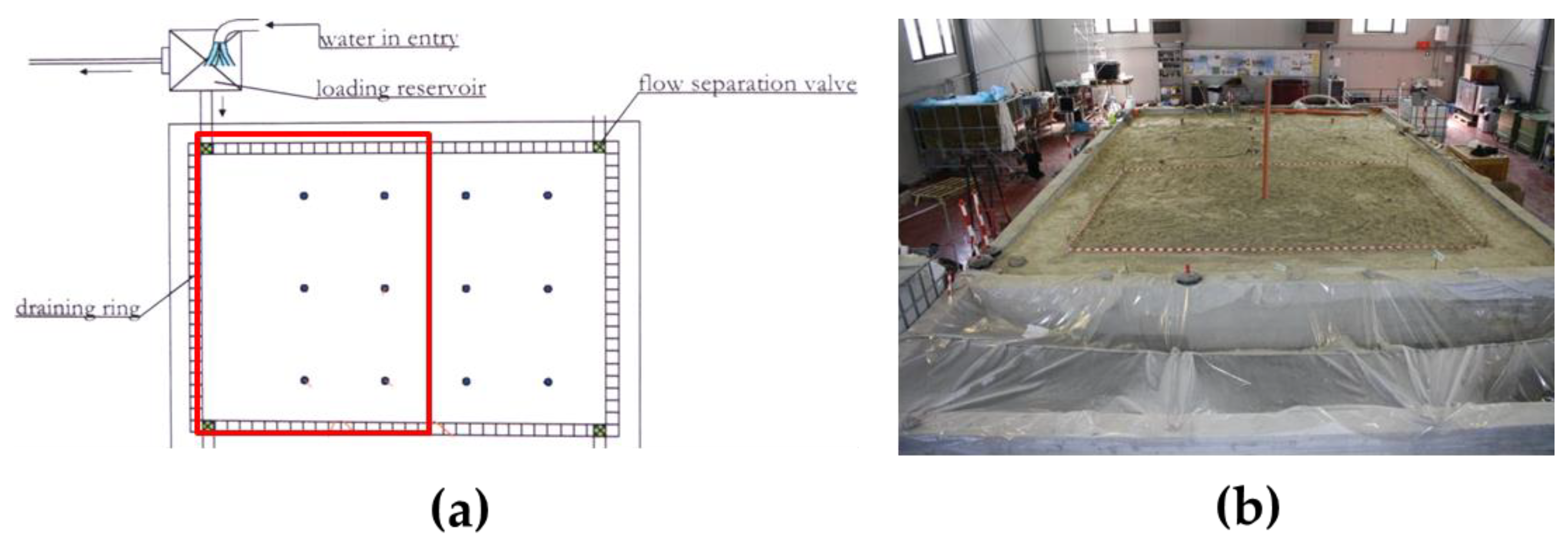
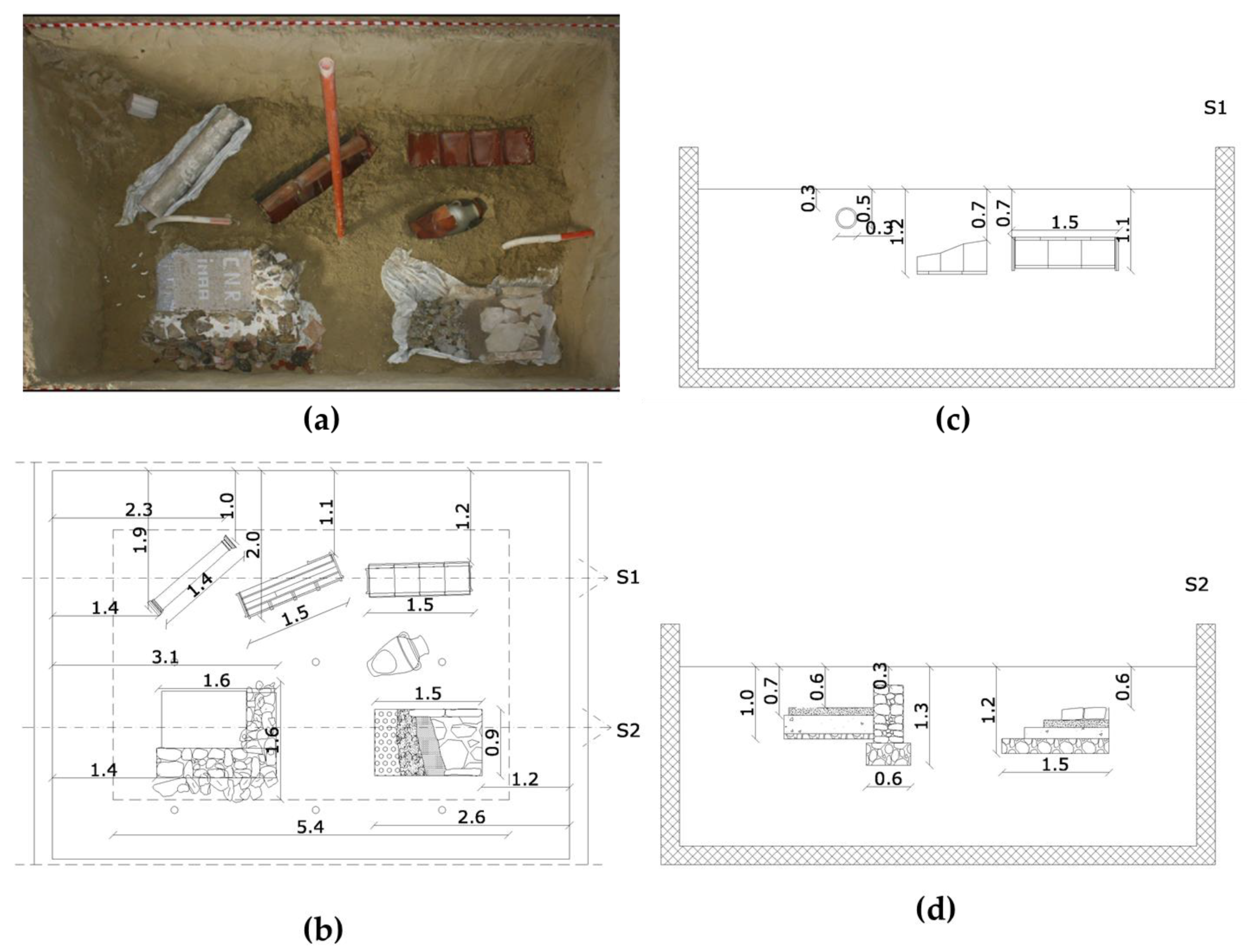
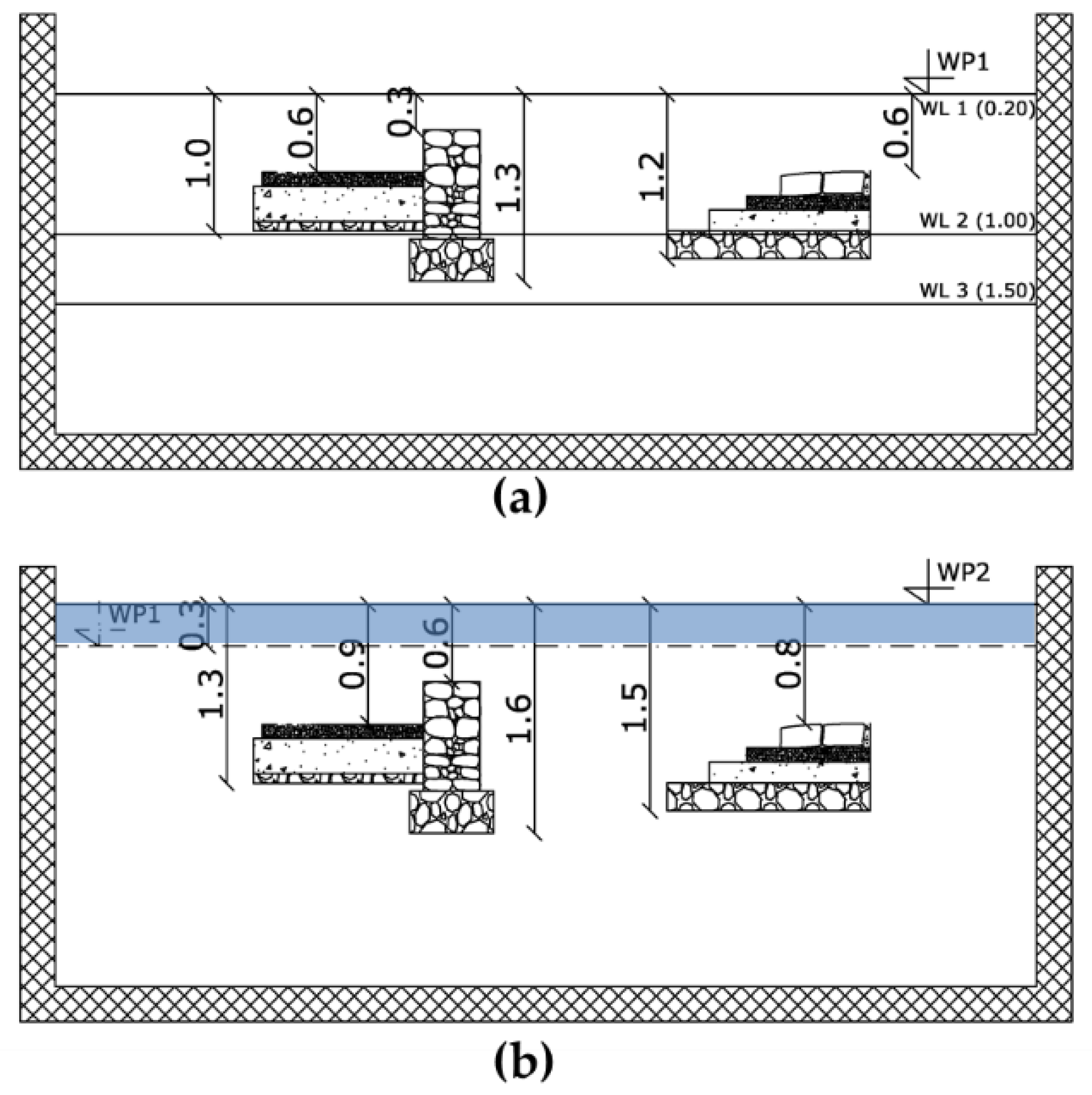
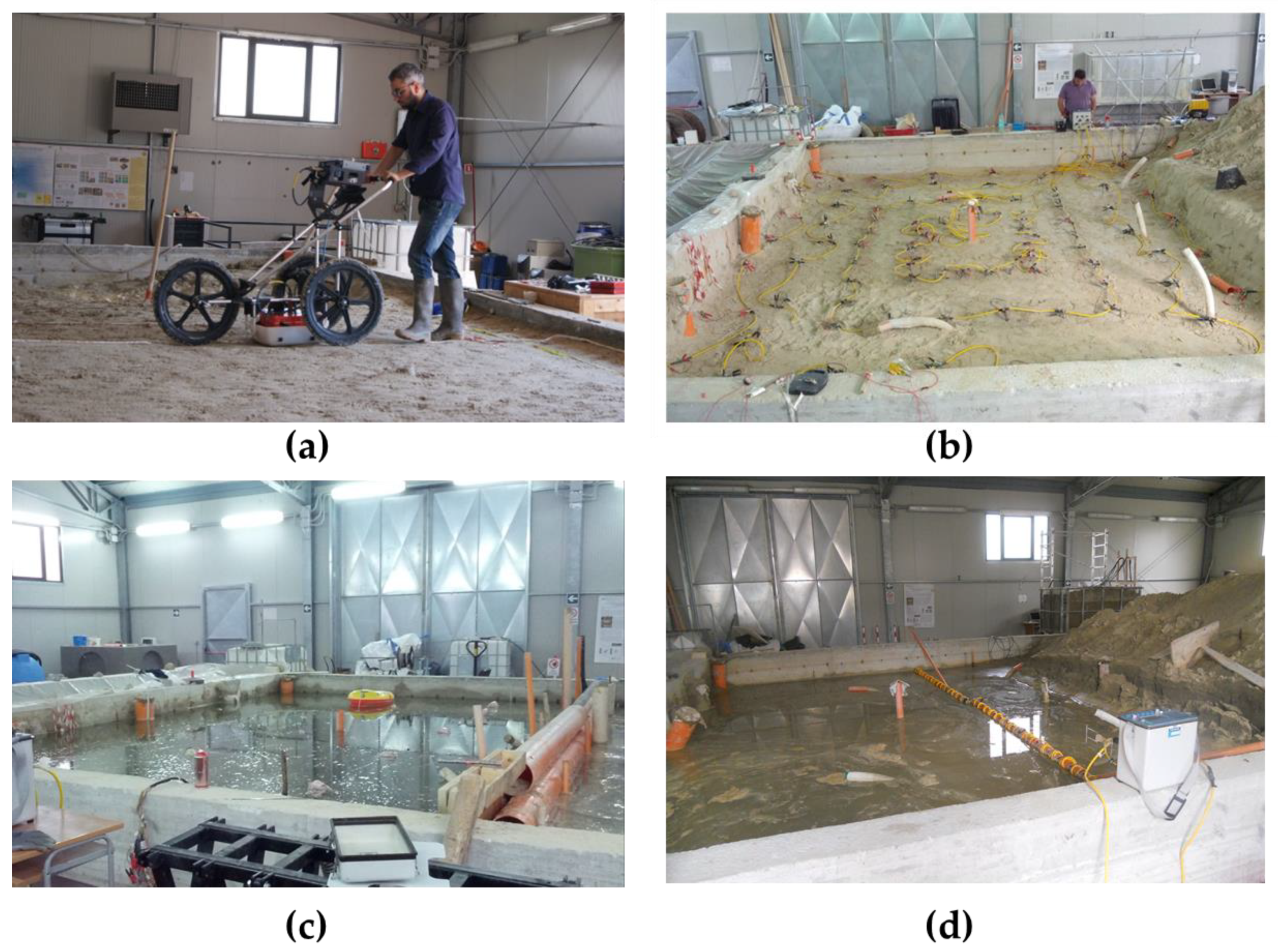
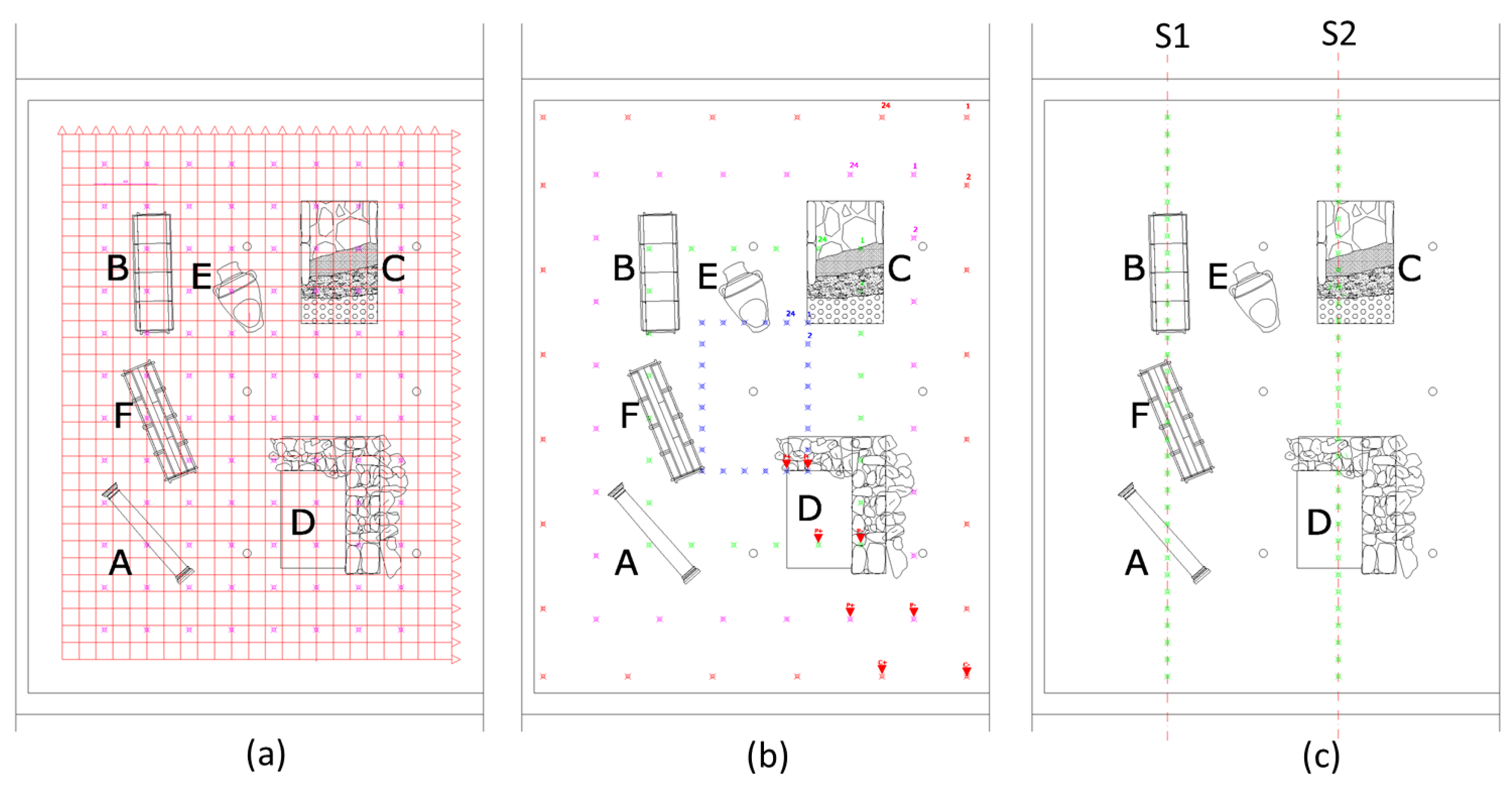
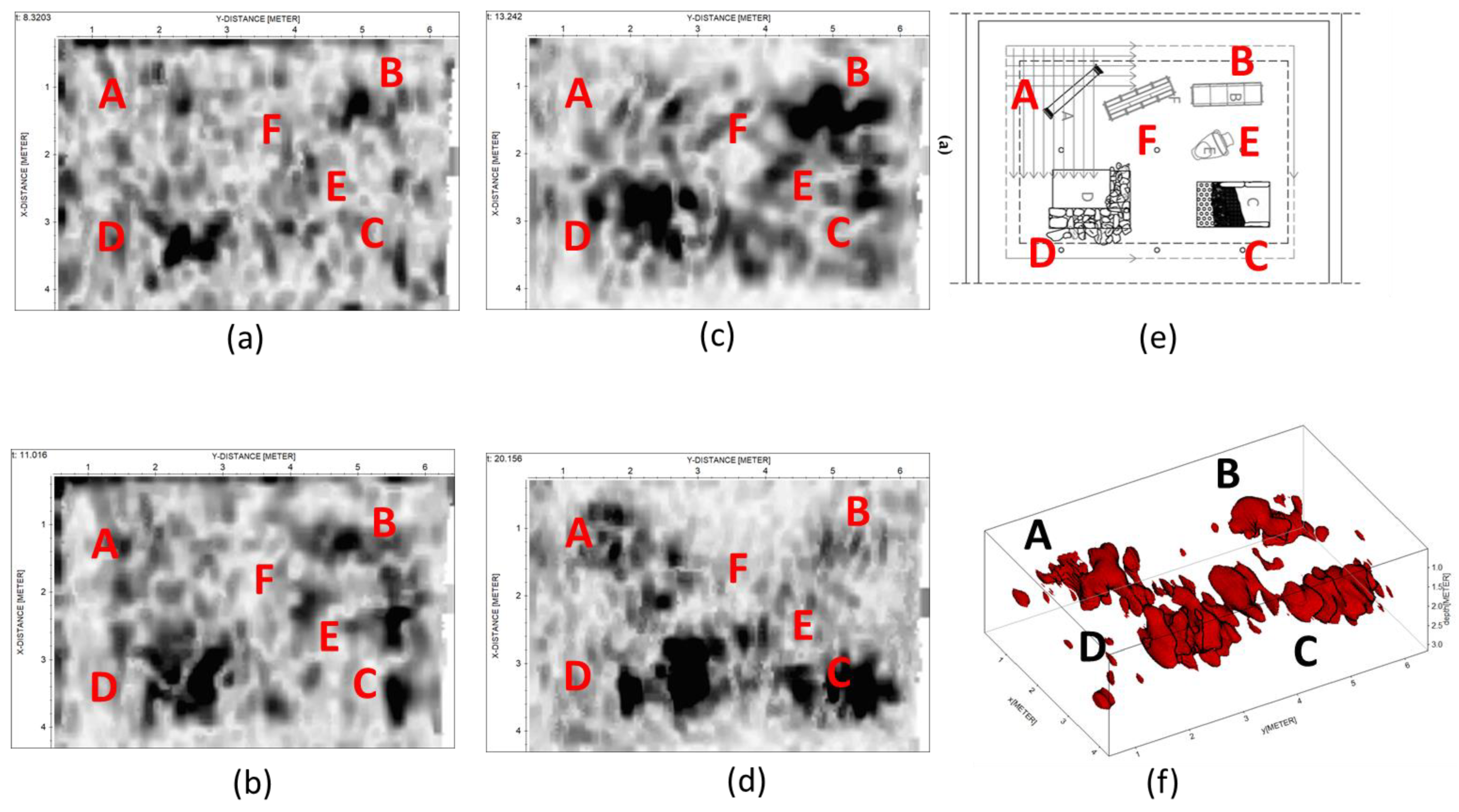
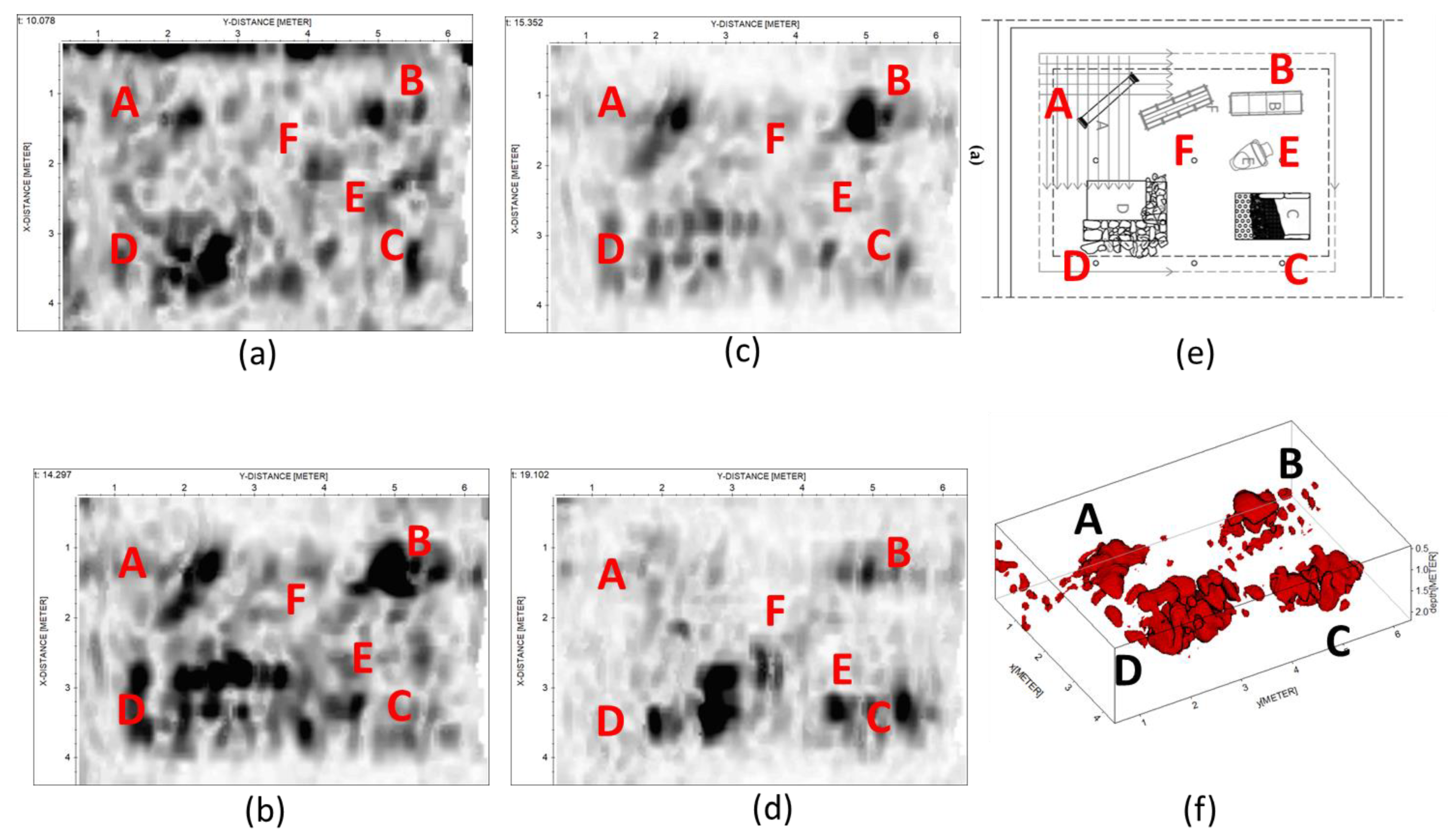
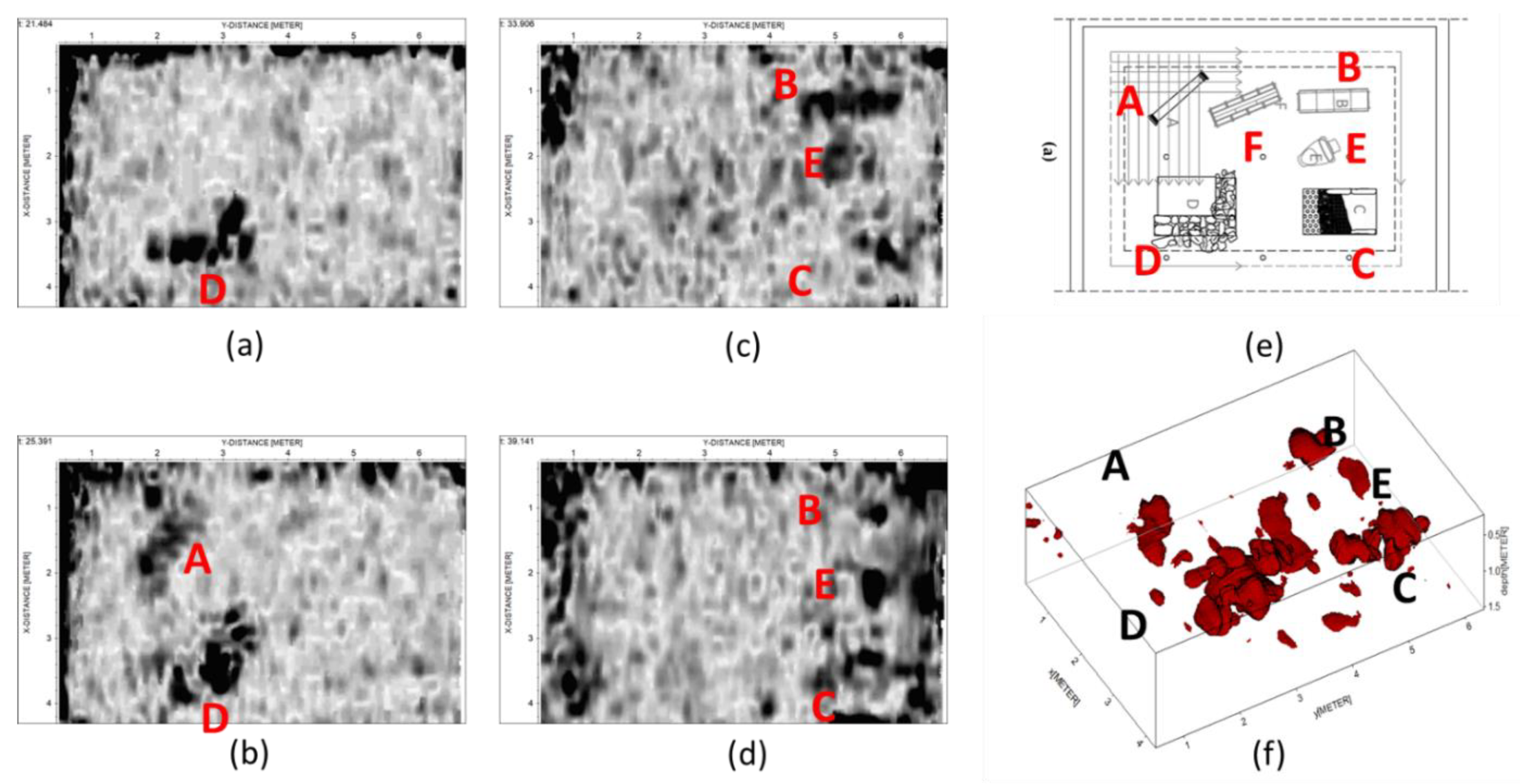
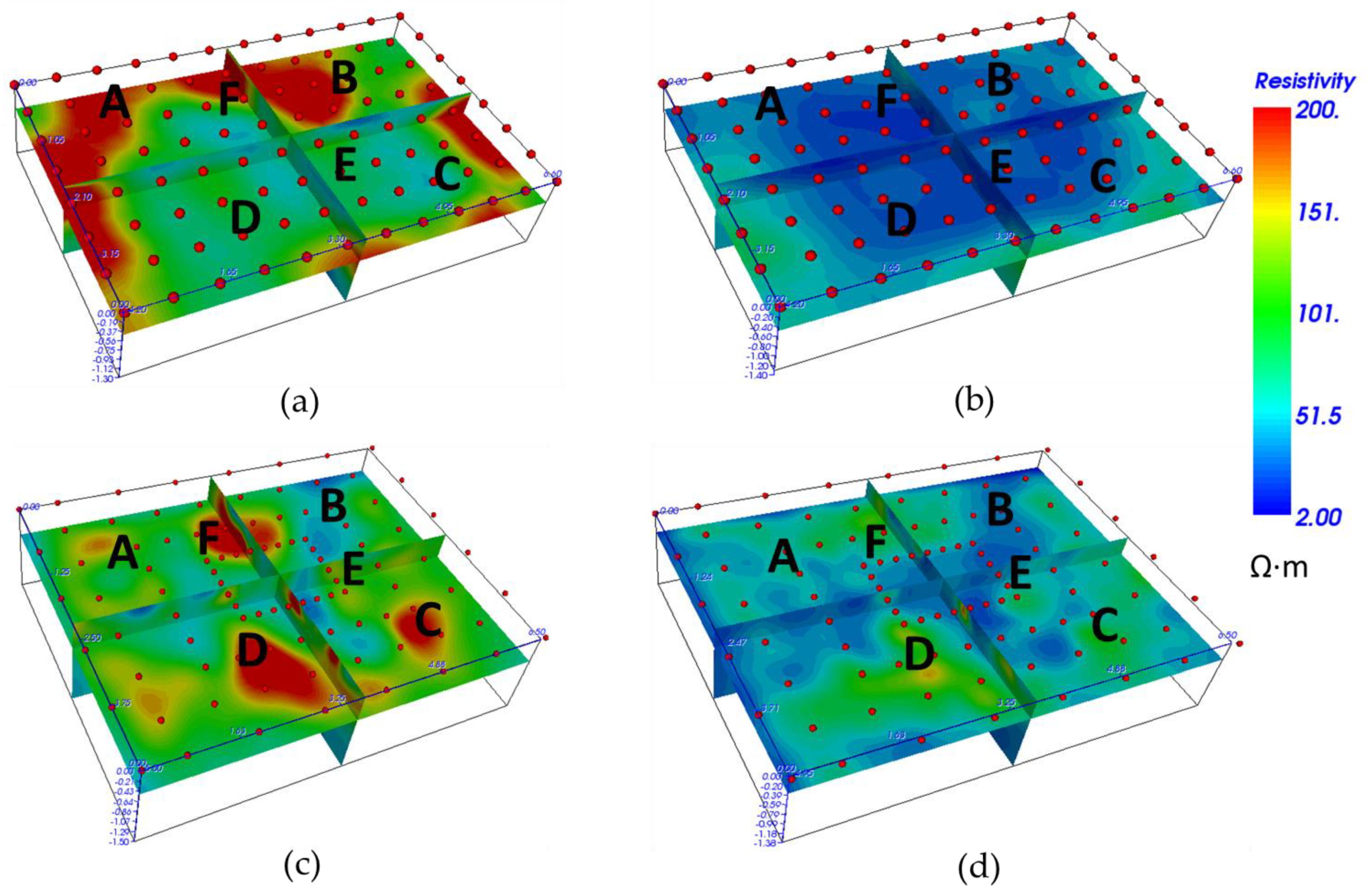
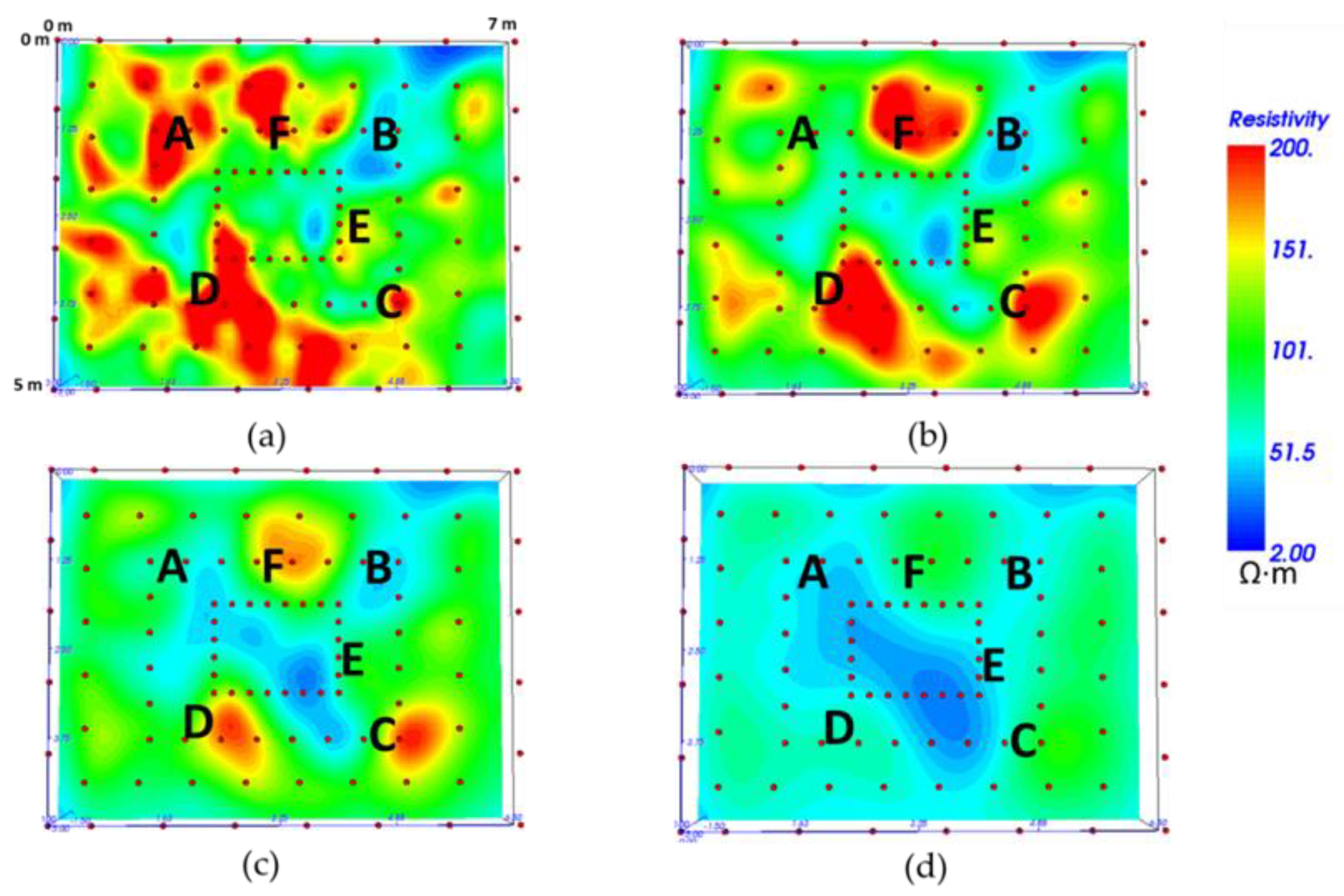
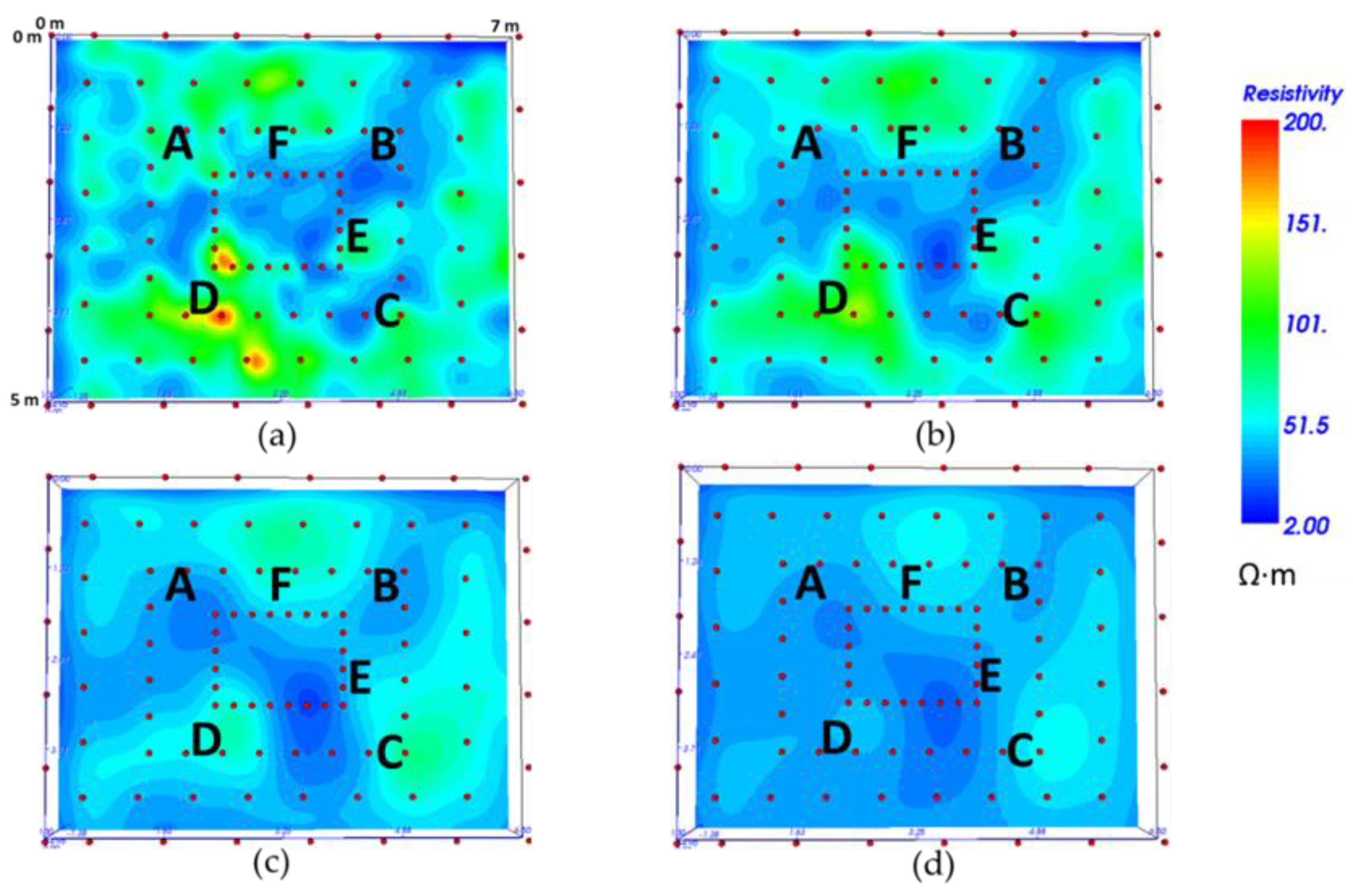



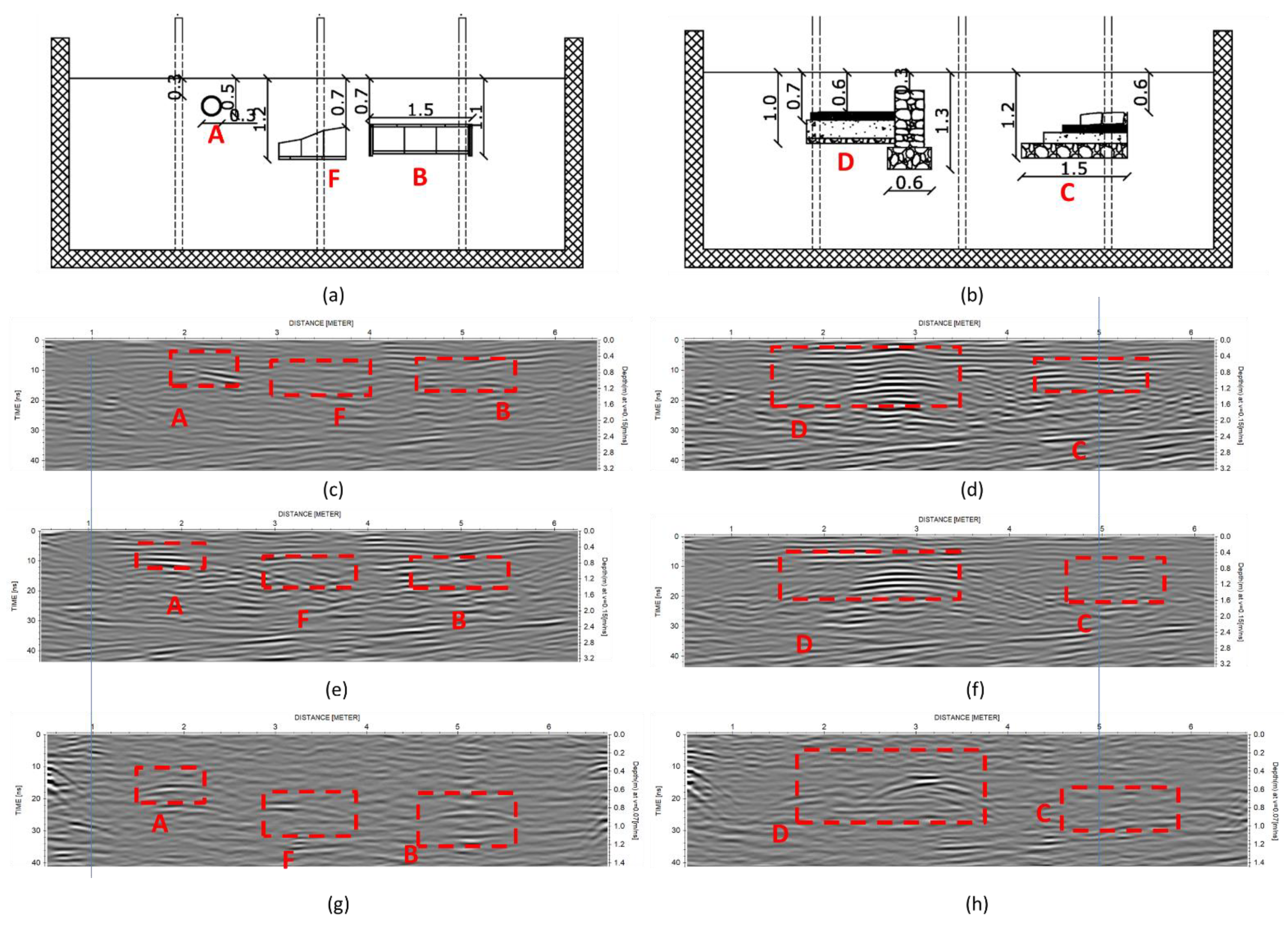

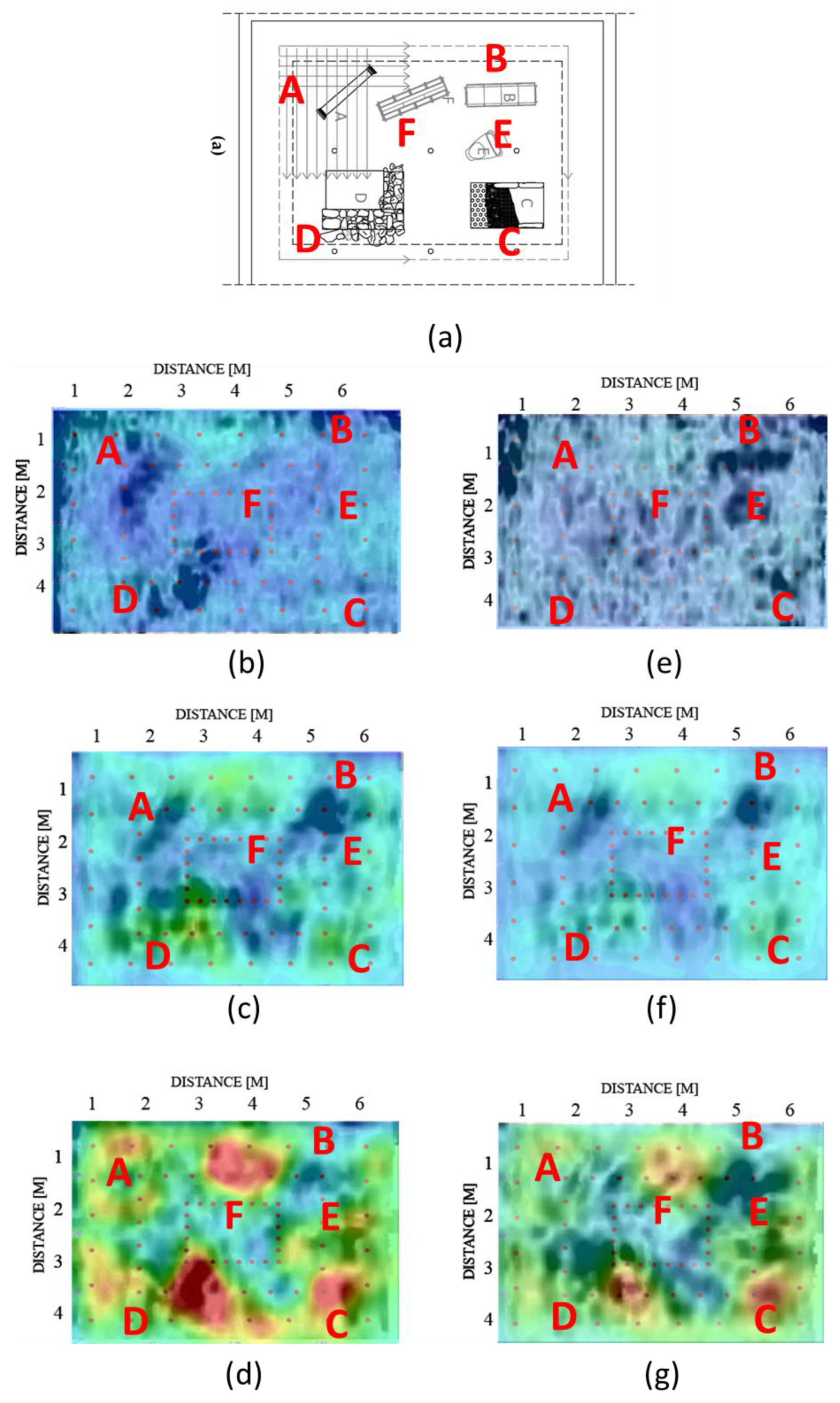
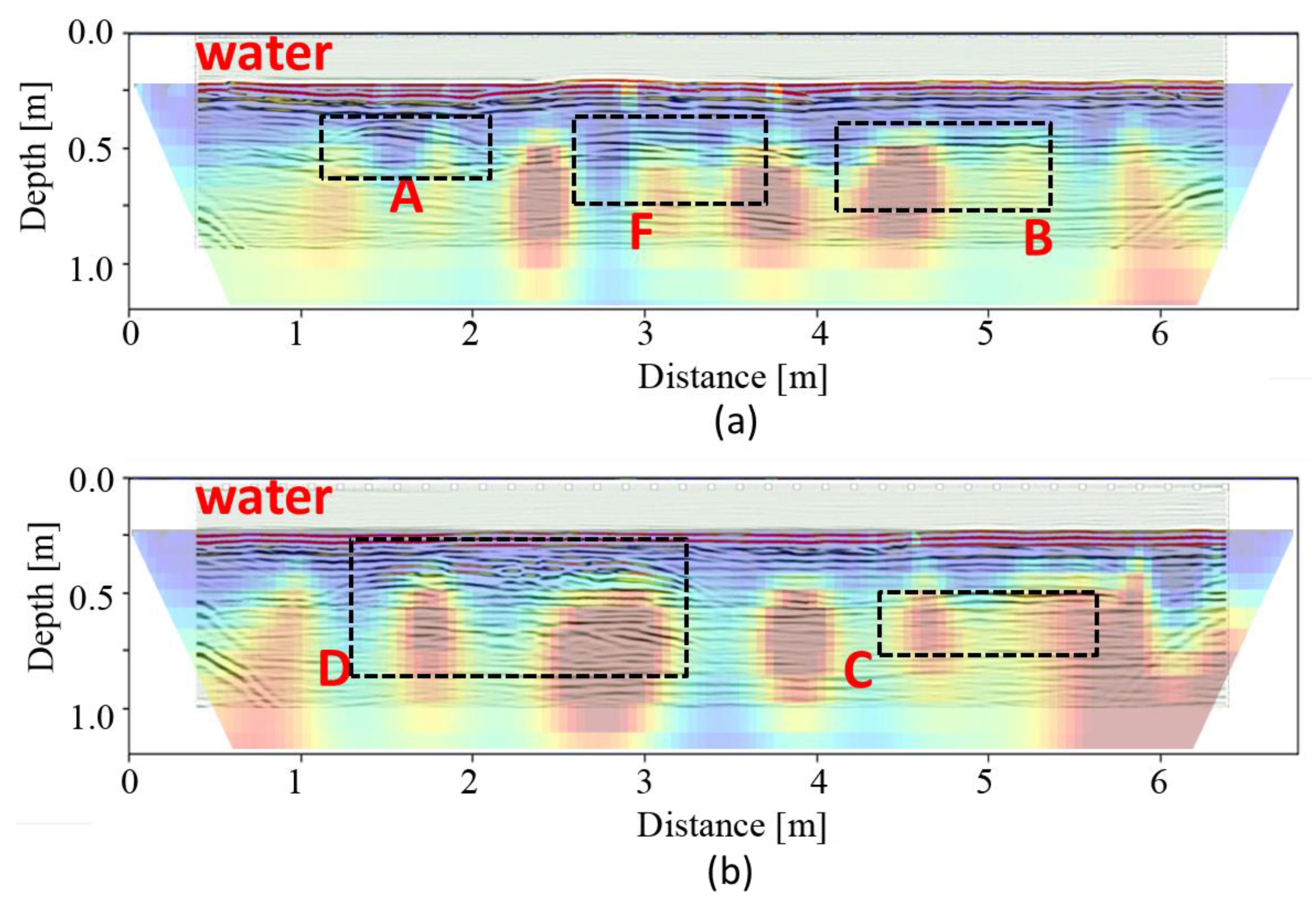

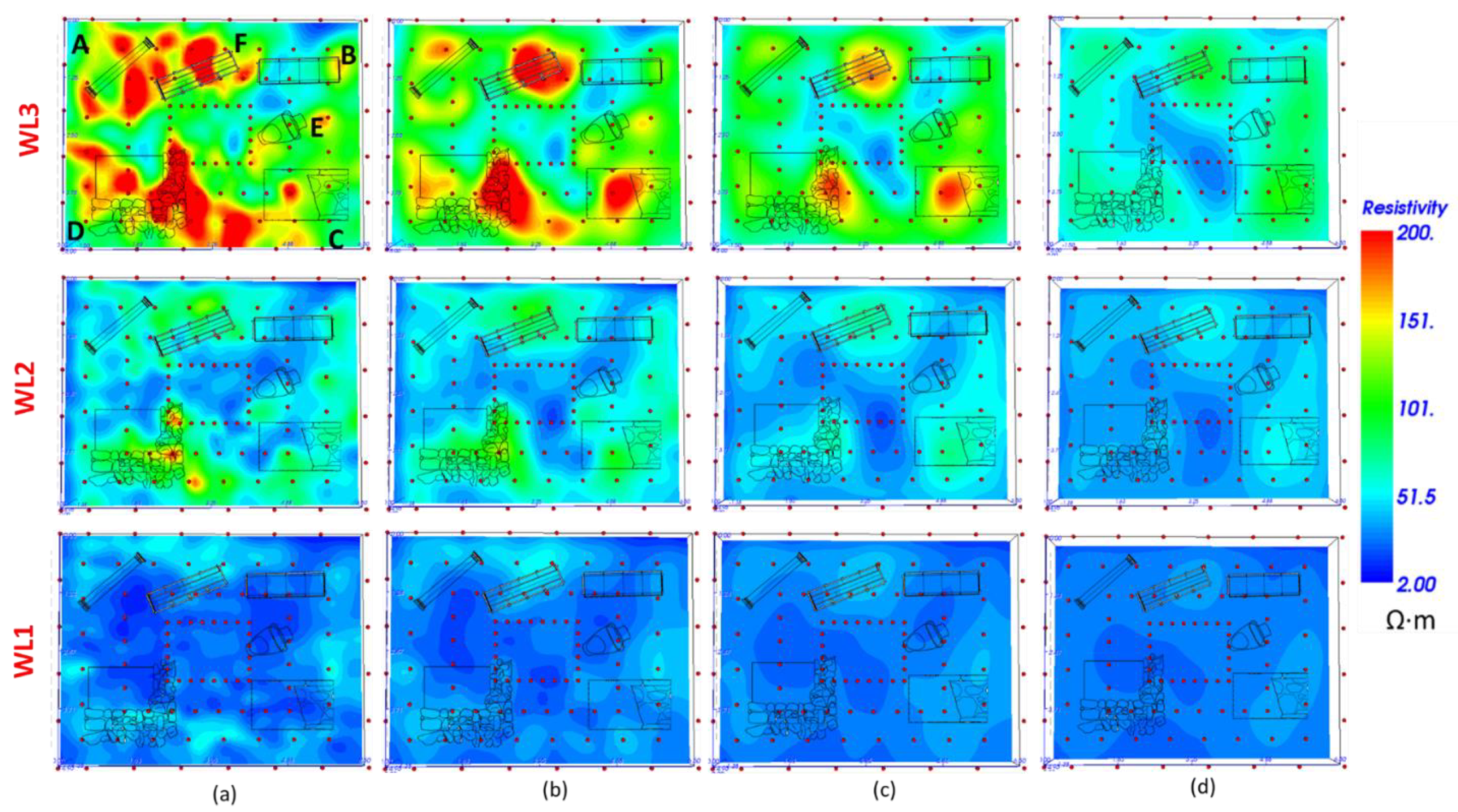
| Chemical and Hydrogeological Parameters of the Sand Used for the Investigation | ||||||
|---|---|---|---|---|---|---|
| SiO2 | Al2O3 | Fe2O3 | CaO | K2O | ||
| % | 93.00 | 2.50 | 0.60 | 1.50 | 1.15 | |
| Particle Size Characteristics | ||||||
| d (mm) | 1–0.50 | 0.50–0.250 | 0.250–0.125 | 0.125–0.063 | 0.063–0.032 | >0.032 |
| % | 0.00 | 0.14 | 3.70 | 86.34 | 7.92 | 1.08 |
| Hydrogeological Properties | ||||||
| dm (mm) | Kmax (m/s) | Φ (%) | ||||
| 0.09 | 4 × 10−5 | 45–50 | ||||
| Element | Material | Dielectric Permittivity | Electrical Resistivity (Ωm) |
|---|---|---|---|
| Column (A) | Marble | 3.5 | 100–1000 |
| Rect. Tomb (B), Enchytrismos (E) and Capuchin Tomb | Fried Clay | 7–10 | 100–500 |
| Paved Road (C) | Calcareous Rocks (gravels and sand) | 8–10 | 100–1000 |
| Stone Wall (D) | Calcareous Rocks and Hydraulic Cement Mortar | 8 | 100–1000 |
| Background Sand | Silica Sand (from dry to water saturated condition) | 5–25 | 20–100 |
| WP1 | WL1 | WL2 | WL3 | |||||||||
|---|---|---|---|---|---|---|---|---|---|---|---|---|
| Buried Object | GPR | ERT | GPR | ERT | GPR | ERT | ||||||
| Pos. | Size | Pos. | Size | Pos. | Size | Pos. | Size | Pos. | Size | Pos. | Size | |
| Column (A) | ✔ | ✔✔ | ✔ | ✔ | ✔ | ✔✔ | ✔ | ✔ | ✔ | ✔ | ✔ | ✔ |
| Rect. Tomb (B) | ✔✔✔ | ✔✔✔ | ✗ | ✗ | ✔✔✔ | ✔✔ | ✔ | ✗ | ✔✔✔ | ✔✔ | ✔ | ✔ |
| Paved Road (C) | ✔ | ✔ | ✗ | ✗ | ✔✔ | ✔✔ | ✔ | ✔ | ✔✔✔ | ✔✔ | ✔✔ | ✔✔ |
| Stone Wall (D) | ✔✔✔ | ✔✔ | ✔ | ✔ | ✔✔✔ | ✔✔ | ✔✔✔ | ✔✔✔ | ✔✔✔ | ✔✔ | ✔✔✔ | ✔✔ |
| Enchytrismos (E) | ✔✔✔ | ✔✔✔ | ✗ | ✗ | ✗ | ✗ | ✔ | ✔ | ✔ | ✗ | ✔ | ✔ |
| Capuch. Tomb (F) | ✗ | ✗ | ✔ | ✔ | ✔ | ✗ | ✔✔ | ✔✔ | ✔ | ✗ | ✔✔✔ | ✔✔ |
Publisher’s Note: MDPI stays neutral with regard to jurisdictional claims in published maps and institutional affiliations. |
© 2022 by the authors. Licensee MDPI, Basel, Switzerland. This article is an open access article distributed under the terms and conditions of the Creative Commons Attribution (CC BY) license (https://creativecommons.org/licenses/by/4.0/).
Share and Cite
Capozzoli, L.; Giampaolo, V.; De Martino, G.; Perciante, F.; Lapenna, V.; Rizzo, E. ERT and GPR Prospecting Applied to Unsaturated and Subwater Analogue Archaeological Site in a Full Scale Laboratory. Appl. Sci. 2022, 12, 1126. https://doi.org/10.3390/app12031126
Capozzoli L, Giampaolo V, De Martino G, Perciante F, Lapenna V, Rizzo E. ERT and GPR Prospecting Applied to Unsaturated and Subwater Analogue Archaeological Site in a Full Scale Laboratory. Applied Sciences. 2022; 12(3):1126. https://doi.org/10.3390/app12031126
Chicago/Turabian StyleCapozzoli, Luigi, Valeria Giampaolo, Gregory De Martino, Felice Perciante, Vincenzo Lapenna, and Enzo Rizzo. 2022. "ERT and GPR Prospecting Applied to Unsaturated and Subwater Analogue Archaeological Site in a Full Scale Laboratory" Applied Sciences 12, no. 3: 1126. https://doi.org/10.3390/app12031126
APA StyleCapozzoli, L., Giampaolo, V., De Martino, G., Perciante, F., Lapenna, V., & Rizzo, E. (2022). ERT and GPR Prospecting Applied to Unsaturated and Subwater Analogue Archaeological Site in a Full Scale Laboratory. Applied Sciences, 12(3), 1126. https://doi.org/10.3390/app12031126









